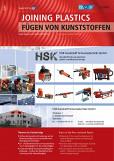Structural direct joints between metal and plastic – Influences of the surface structuring on the bonding strength
Authors: Prof. Dr. rer. nat. Ralf Hellmann, M. Eng. David Sommer, Dr.-Ing. Maurice Langer, Dr. Eduard Kraus, Dr.-Ing. Gernot Hochleitner, Dipl.-Ing. (FH) Christian Laugwitz, M. Sc. Julian Hesselbach, M. Sc. Benjamin Förster
DOI: https://doi.org/10.53192/JP20240292
Within the framework of the presented investigations, it could be shown that the suitable surface structuring of metal substrates on the basis of suitable surface structures leads to structural direct joints between metal and plastic. Not only subtractive laser structuring but also additively manufactured structural elements can be utilised in this respect. Here, the geometrical configuration of such anchoring structures exerts very great influences on the bonding strength. Therefore, this is suitable, in particular, for achieving structural joints. With both variants, optimised process management methods could be used for the production of undercuts which increase the resulting bonding strengths to a crucial extent when the joints are subjected to cross tension loads. It was possible to prove that the strengths had increased by min. 40%. In addition
to the influences of the surface structuring, it is indicated that higher base material strengths of the utilised polymers have positive influences on the attainable bonding strengths.
An active subscription enables you to download articles or entire issues as PDF-files. If you already are a subscriber, please login. More information about the subscription
















